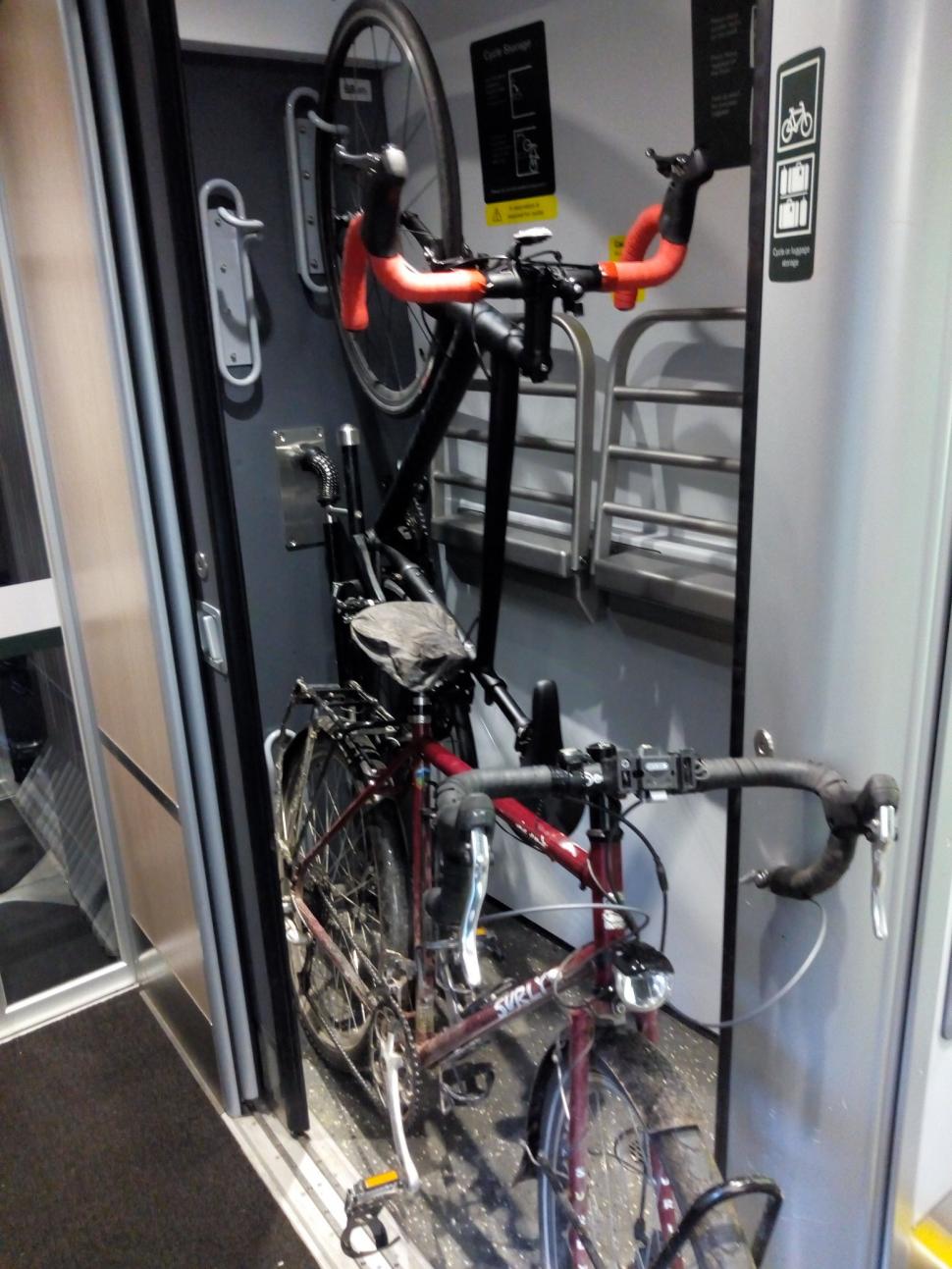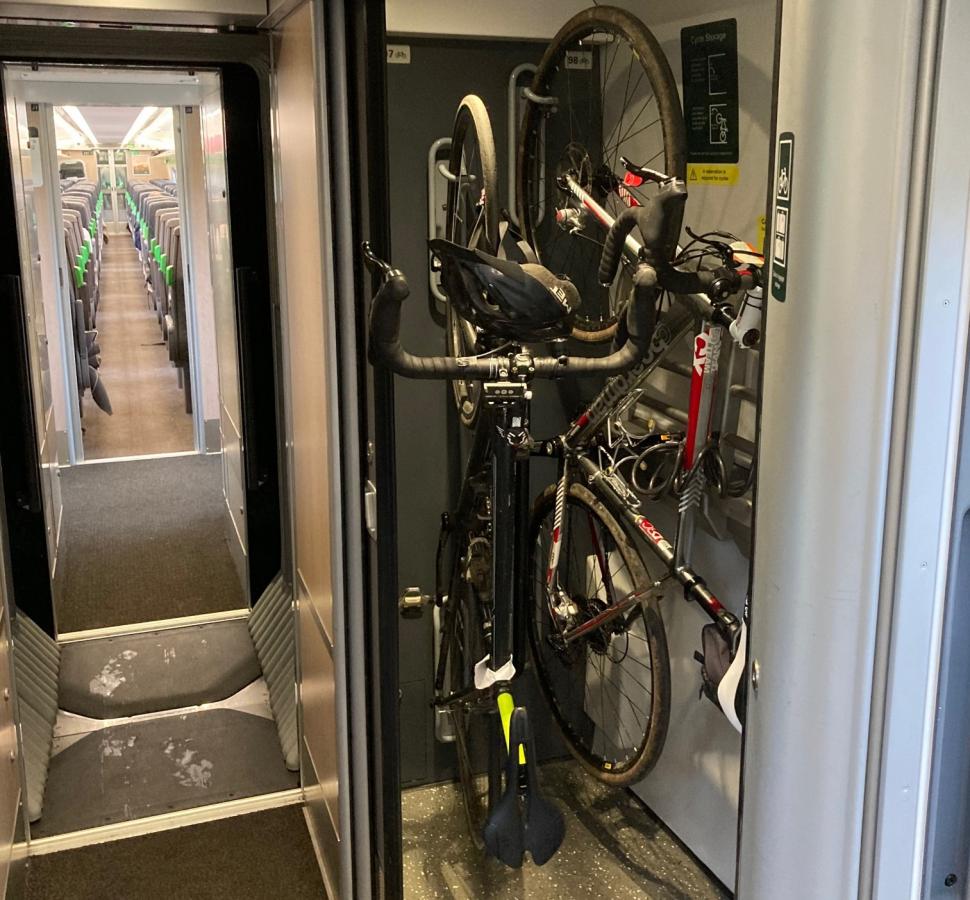“Vertical bike storage is discriminatory and should be outright …
A few weeks ago, we asked our readers to tell us about their experiences of what should, on the face of it, be a relatively straightforward task: taking a bike on a train in the UK. After we were bombarded with responses – which ranged from unbridled positivity to Stephen King-esque horror stories – Jack and Ryan sat down with rail expert Gareth Dennis to get to the bottom of why the issue of bikes on trains continues to be such an emotive topic, and what needs to be done to make the rail network more accessible for everyone.
Listen to the road.cc Podcast on Apple PodcastsListen to the road.cc Podcast on SpotifyListen to the road.cc Podcast on Amazon Music[1][2][3]
A railway design engineer, writer, podcaster, and lecturer at the Birmingham Centre for Railway Research and Education, Gareth is also a cyclist, so knows all too well the difficulties people with bikes can face on the UK’s trains (while also helpfully occupying the centre of the train and cycling nerd Venn diagram).
On the latest episode of the road.cc Podcast[4] (which you can listen to above), Gareth discusses the issues impacting how cyclists use trains in Great Britain, including limited and inadequate space for storage, as well as a lack of accessibility and clarity for train users with bikes, wheelchairs, and buggies.
He also chats about the challenges currently hindering the creation of more bike spaces on trains, such as the pressures on designers to maximise the number of seats on popular and congested routes, and Great Britain’s present system of rolling stock leasing companies, whose desire to build ‘all-in-one’ style trains limits the possibilities for operators to alter trains to create more bike storage.

> LNER to rethink "dangerous" bike storage on new trains[5]
However, there is one attempt to create space for bikes that leaves Gareth (and road.cc editor Jack) “sweating with rage”: vertical bike storage.
“Vertical storage should be outright banned,” he argues unequivocally. “For the middle-aged men in Lycra with their very expensive road bikes – which is basically all vertical storage is designed for – the vertical storage wrecks their bike.
“For everyone else, and we shouldn’t be designing for that narrow case anyway, how does it work for most people who can’t lift their bikes up? What about people who rely on their bikes as a mobility aid? What about less confident cyclists who want a bigger, sturdier bike? What about people with non-standard cycles, trikes, those with attachment to wheelchairs, longer bikes, tandems?
“How are any of those people able to use vertical storage? They can’t. It’s excluding people from using the railway. They are being denied the freedom of movement by the structure of our railways and, ultimately, the Secretary of State for Transport.”
> Trying to take a very expensive bike on a GWR train is hard work[6]
A scathing critic of the government’s approach to accessibility on trains, Gareth also noted that this lack of accessibility extends onto the platform, where he argues that there is legal precedent, based on cases brought against stations without ramps, to challenge the lack of accessibility for people with non-standard cycles on Britain’s railways.
“Vertical storage is discriminatory, and I can’t believe it was allowed to be brought in,” he says. “It was one of those situations where designers and engineers went, ‘Right, we’ve got the spec, the DfT have said that we need to fit two bicycles onto this train. But we have to do so in the minimum possible floor space. We’ll do it vertically – genius!’
“The fact that anyone designed that, stepped back and thought ‘that looks good’… I can understand the pressures behind how it ended up happening, but it shouldn’t have. And I’m afraid we’ll probably see vertical storage popping up in brand new trains for a little while yet.
“If someone is out there who is usefully litigious, you have an easy case to make if you take it to the appropriate authorities. Those vertical bike hangars are discriminatory, and they breach a variety of legislation. Sue them!”

> Doctor thrown off train because he hadn't reserved space for bike - even though there were four available[7]
Beyond legal cases, Gareth also believes that a radical step change in capacity is needed to ensure adequate provision for people cycling and wheeling on the rail network.
“We need to be upgrading for the long term, due to climate change. We need to build more capacity on the railways, that goes beyond maximising the number of seats. Because the reality is those seats are full anyway,” he said.
“So we need a step change in capacity, which funnily enough is, until the recent government changes, what High Speed 2 would deliver. Okay, you might want to put your bike on High Speed 2, but that’s less what it’s about. High Speed 2 takes all the people who might have luggage, but aren’t really travelling for active leisure.
“That then allows you to start thinking differently about the services that are still running on the East Coast Main Line, because they’re the ones going through the local stops you want to get off and on at anyway.
“So, all of a sudden you stop saying the solution is maximise the number of seats. You can start going, right, we’ll still run the same number of trains, we’ll still have a ten-car train to maximise length, but maybe we can dedicate half a coach to bike storage.
“You can start being flexible about how you use that space. You can start thinking about how to provide better facilities for disabled users, for families. Suddenly what you get by increasing the capacity of the overall system is that you can start thinking creatively about the existing trains.
“The thing to get angry about is that the government is dithering and cancelling parts of HS2 as quickly as it can. Because HS2 is a good example of a step change in capacity that will allow a massive leap – it means you can do things a lot more radically on the existing railway network.”
The road.cc Podcast is available on Apple Podcasts[8], Spotify[9], and Amazon Music[10], and if you have an Alexa you can just tell it to play the road.cc Podcast. It’s also embedded further up the page, so you can just press play.
To celebrate the road.cc Podcast’s landmark 50th episode last time out, we gave away some schwag to three listeners. So, congratulations to Rob, John, and Darren, who will be receiving some road.cc goodies in the post.
At the time of broadcast, our listeners can also get a free Hammerhead Heart Rate Monitor with the purchase of a Hammerhead Karoo 2. Visit hammerhead.io[11] right now and use promo code ROADCC at checkout to get yours.
References
- ^ Listen to the road.cc Podcast on Apple Podcasts (podcasts.apple.com)
- ^ Listen to the road.cc Podcast on Spotify (open.spotify.com)
- ^ Listen to the road.cc Podcast on Amazon Music (go.skimresources.com)
- ^ road.cc Podcast (road.cc)
- ^ > LNER to rethink "dangerous" bike storage on new trains (road.cc)
- ^ > Trying to take a very expensive bike on a GWR train is hard work (road.cc)
- ^ > Doctor thrown off train because he hadn't reserved space for bike - even though there were four available (road.cc)
- ^ Apple Podcasts (go.skimresources.com)
- ^ Spotify (open.spotify.com)
- ^ Amazon Music (go.skimresources.com)
- ^ hammerhead.io (www.uk.hammerhead.io)